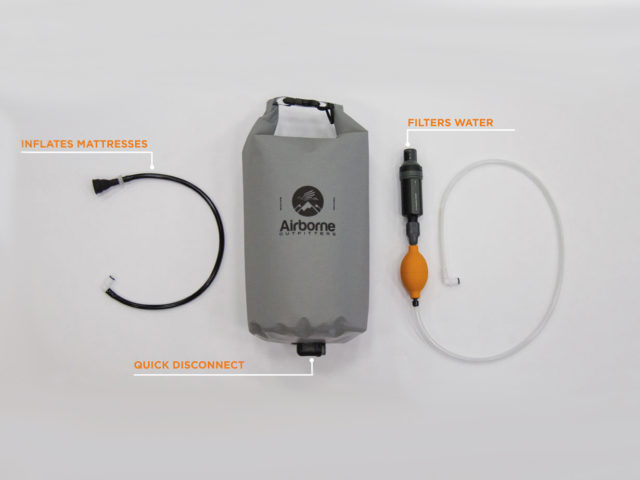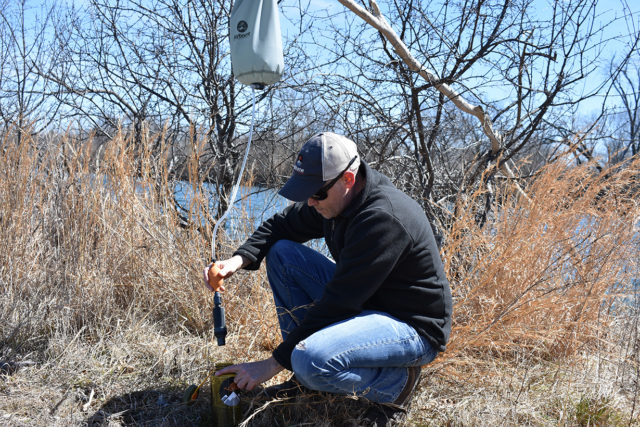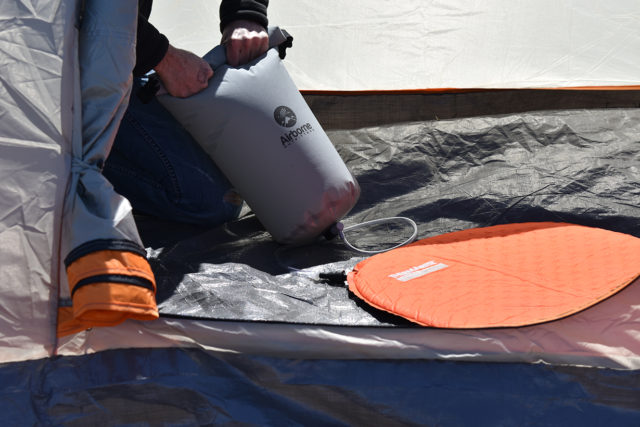
Airborne Outfitters Bitterroot Dry Bag
Dry Bag Volume: 18 Liters
Dry Bag Material: 200-denier Nylon, NSF-approved water-potable
Filter: Aquamira Frontier Max
Filter Removes: Viruses, bacteria, Cryptosporidium and Giardia
Filter Life: 120 gallons
Filter Speed: approximately ⅓ liter per minute
Stated Total Weight: ~354 grams / 12.5 oz
Blister’s Measured Weight:
- Dry Bag: 150 grams
- Aquamira Frontier Max: 79 grams
- Filter Hose: 103 grams
- Inflation Hose: 38 grams
- Total Weight: 370 grams
MSRP: $145 (currently available on Kickstarter for $85)
Intro
While a dry bag can sometimes be an afterthought when venturing into the backcountry, it’s one thing you really don’t want to have malfunction while in the mountains, on a lake, or tumbling down a river after dumping your boat.
You know another thing you really don’t want to have malfunction when away from the safe confines of your home? Your water filter.
So, it makes a whole lot of sense that Airborne Outfitters chose to combine the two, and then also figure out a way to use the dry bag to inflate a camping air mattress.
Airborne Outfitters is a young company started by Jason Evatt, a 23-year military veteran who started sewing and creating gear as an outlet to help with PTSD. The Bitterroot 3-in-1 Dry Bag is currently being funded on Kickstarter (it’s already surpassed its goal, and early-bird orders are estimated to be delivered in July).
I’ve had the chance to do an initial test of the Bitterroot Dry Bag, and will go over my initial impressions below. I’ll then be updating this review after using the Bitterroot Dry Bag some more in the field this summer.
But before we get to my thoughts, it’s definitely worth watching Jason’s explanation of the product, shown below. Here at Blister, we see a lot of obnoxious, misleading, and downright awful marketing copy. However, Jason’s concise, honest, and hilarious demonstration of what the Bitterroot Dry Bag does is a refreshing change from what we usually see. Check it out:
https://www.youtube.com/watch?v=FeMOogfUo_0
Dry Bag
While fairly unassuming at first, the actual dry bag part of the Bitterroot system has a few features that make it stand out.
First, it’s made of a 200-denier nylon fabric that’s National Sanitation Foundation (NSF) approved as a water potable material, which is why you can use it to store food, water, etc. Just make sure to clean the inside between filtering water and using the bag to store food.
And on that note, it’s pretty easy to clean the Bitterroot Dry Bag since the interior is coated with a hydrophobic material, and liquids can be easily shaken off. This also helps the bag dry very quickly when turned inside-out.
The Bitterroot Dry Bag can also hold water up to 315°F, which means that you can fill it with boiling water and toss it in your sleeping bag for some extra heat on cold nights.
Apart from the material, the Bitterroot Dry Bag has a standard rolltop closure with beefy plastic buckles and a plastic triangle for hanging the bag.
The 200-denier nylon fabric of the Bitterroot Dry Bag fits around the middle of the pack in terms of weight. It’s not the lightest, and it’s not the burliest. I imagine it should strike a pretty nice balance for all-around use, and will update with any notes on durability. All the materials and components of the Bitterroot Dry Bag system are made in the U.S. The
Lastly, the Bitterroot Dry Bag has a quick-connect valve on the bottom that serves as the integration point for the water filter and inflation hose.
Filter
The Bitterroot Dry Bag comes with an Aquamira Frontier Max in-line filter that is certified by IAPMO R&T to EPA standards to remove >99.99% of viruses, 99.99999% of bacteria and 99.95% of protozoans for 120 gallons of in the field use. It’s also certified lead free (ANSI/NSF-372), and is also BPA free, chemical free and iodine free.
Because the Frontier Max filters out viruses, bacteria, and protozoa, you can use it to drink water from any stream, lake, or river. This is an important difference between the Bitterroot system and other in-line filters like the Platypus GravityWorks system, which only filters out bacteria and protozoa, and not viruses.
While this makes the Bitterroot system more versatile, it does affect filtering time. The Bitterroot system has a stated filtering rate of around ⅓ of a liter every minute. My testing at home confirms this number is pretty accurate. For reference, the GravityWorks system filters around 1.5 liters per minute.

However, the nice thing about a gravity-based filtering system is that, once set up and hanging from something, you can just sit back and let the filter do its thing. As long as you have something to hang the bag from, this is a lot nicer than having to pump the water by hand. You simply fill the dry bag up with your “dirty” water, attach the filter and filter hose, use the small in-line pump to get the water flowing, and you’ll have drinkable water flowing out of the filter.
It’s also important to note that, since the Bitterroot Dry Bag has 18 liters of volume, you can filter a sh*t ton of water before having to refill the bag. This makes it a great option for larger groups, or when setting up a basecamp. It also means that, if you’re not sure when you’ll have access to water next, you can fill the Bitterroot up with some “dirty” water, take it with you to the next spot, and filter the water later.
The Frontier Max can filter 120 gallons of water (roughly 454 liters) per filter cartridge. That’s less than a third the life of the GravityWorks filter, but again, the Frontier Max does filter out viruses. Replacement filters can be purchased from Aquamira, with the virus filter costing $49.99, and the bacteria / protozoa filter costing $19.99
Air Mattress Inflation
The last function of the Bitterroot Dry Bag is as an air pump for your air mattress. The benefit of this is that you (1) don’t have to blow up the mattress with your lungs (which is especially nice if you’re camping at high elevations), and (2) you’re not blowing a bunch of moisture from your breath into the air mattress, which should make the mattress a bit warmer in cold temps.

Airborne Outfitters says that the Bitterroot Dry Bag is compatible with Nemo, Thermarest, Klymit, REI, & some Cabelas-brand nozzles. I can confirm that it works very well for blowing up the Thermarest NeoAir series. Simply hook up the Bitterroot’s black hose to the dry bag, attach the hose to the mattresses nozzle using the included attachment, trap some air in the dry bag, roll it down to push the air into the mattress, and repeat until your mattress is full.
Another bonus feature of the Bitterroot’s valve system is that, when you’re using it as a dry bag, you can hook up the mattress hose to the outside valve and release all the air in the dry bag to decrease its volume.
Bottom Line (For Now)
The Airborne Outfitters Bitterroot Dry Bag combines three important backcountry tools into one sensible package. With the Bitterroot, you get an 18 liter dry bag, an in-line water filter that filters out bacteria, protozoa, and viruses, and a hand pump for your air mattress. I’ll be spending more time with the Bitterroot Dry Bag this summer, taking it on several backpacking and car camping trips. But so far, I’m impressed.

This really is a 3 in one piece of equipment. From filter to pump for inflating a matress. Having a water filtering system is such a priority when out hiking, and being able to combine this with a bag that can hold boiling water is another added bonus. This product is something that I would definitely think about investing in for hiking and outdoor activities.